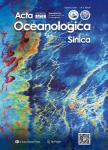Rickettsia-like organism infection associated with mass mortalities of blood clam, Tegillarca granosa, in the Yueqing Bay in China
Rickettsia-like organism infection associated with mass mortalities of blood clam, Tegillarca granosa, in the Yueqing Bay in China作者机构:Laboratory of Marine Life Science and TechnologyCollege of Animal SciencesZhejiang UniversityHangzhou 310029China Fisheries Technical Extension Center of Zhejiang ProvinceHangzhou 310012China
出 版 物:《Acta Oceanologica Sinica》 (海洋学报(英文版))
年 卷 期:2012年第31卷第1期
页 面:106-115页
核心收录:
学科分类:0710[理学-生物学] 0908[农学-水产] 0707[理学-海洋科学] 0906[农学-兽医学] 09[农学]
基 金:Scientific Projects of Zhejiang Province China under contract Nos 2004C23041 and 20080123
主 题:blood clam Tegillarca granosa rickettsia-like organism (RLO) inclusions mass mortalities
摘 要:A series of mass mortalities of the cultured blood clam, Tegillarca granosa, occurred in the Yueqing Bay of China from 2005 to 2009. An obligate intracellular prokaryote, designated as rickettsia-like organism (RLO), was frequently found in the moribund or dead blood clam sample during ultra- structural examination. These organisms were usually round, ellipsoid or occasionally dumbbell- shaped, ranged from approximately 0.28 to 0.71 #m in size and had a trilaminar cell wall. Two reproductive modes of organisms, transverse binary fission and budding, were observed. The or- ganisms were able to form eosinophilic inclusions. Most inclusions were found within epithelial and connective tissues of the mantle, gills and digestive tube. The biological and morphological char- acteristics indicate that these organisms may belong to the family Rickettsiaceae. RLOs exhibited significant pathogenicity. Cytopathological examinations revealed extensive necrosis and destruc- tion in the infected cell. The degree of tissue destruction was positively related to the number of RLO inclusions in the tissues, and the cytopathological effects were positively related to the number of intracellular RLO. RLOs and their inclusions were discovered throughout different disease areas and in different time periods. The infection intensity of the RLOs was positively correlated with the mortality rate of clams. Therefore, RLO infection might be associated with mass mortalities of cultured blood clams in the Yueqing Bay.



